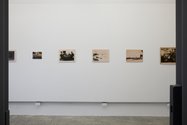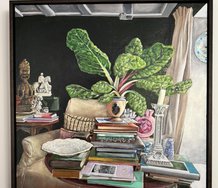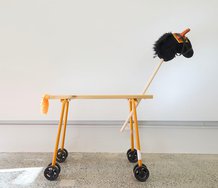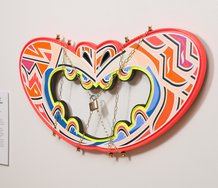Peter Dornauf – 7 November, 2025
So, what's the beef with these ostensibly ‘family snaps'? The point, surely, is the context, which casts a shadow over each of these shots, a chronicle of a slice of a life at a point of crisis. Here is a man facing death each time he climbs aboard the plane, taking photos (on his days off) that on their own and of themselves provide little hint of the drama going on behind the scenes. They are pictures taken by, as it were, a dead man walking, brought to ‘life' later by the grandson.
“Chin up” is an old expression which comes from another age, one we associate with the Victorian period, mid nineteenth century, where a sense of optimism was tempered by apposing forces of doubt and misgivings created by revelations from people like Charles Darwin and the geologists at the time.
We think it typically British, but the phrase originated in the United States in the late nineteenth century, although probably linked to the older British expression, “keep your pecker up”.
What is being encouraged here is the call to demonstrate courage and resolution during times of stress and difficulty. One can imagine Jeeves and Wooster using it at some stage in the 1920’s. One must remain cheerful and positive, mustn’t one, even though the sky might be falling.
The sky was falling literally during World War Two and the phrase, not surprisingly, rose in popularity around this time - the 1940’s.
It was found in letters the servicemen wrote home to family, and one of those who did so was a New Zealand airman, Flight Lieutenant Gordon Allan Webby of the RNZAF. He served as a navigator for bomber planes in England during the war.
He flew a total of 60 missions over Germany, and the fact that over half of the men involved in these missions never returned, must have been a sobering and deeply confronting existential reality. He himself almost never made it twice, and in one such crash, he was the sole survivor, just managing to pull his mangled body from the wreck.
So, one can easily understand how this old expression, chin-up, came back into vogue, a means of fostering emotional resilience in times of extremity. The letter in this case, written by Gordon Webby, in which the phrase is found, reads: “Goodbye for now and keep the old chin up and try to be patient, and keep loving me ‘cos I will be thinking of you plenty.”
Timothy Webby, the grandson, is a photographic artist who is in possession not only of the letter, but photographs taken by his grandfather during the war period. This helps explain the title of the show, KEEP THE OLD CHIN UP, which presents a selection of those photographs taken some time between 1939 and 1942. Timothy Webby has selected the images and reprocessed them, changing the size (enlarging) and altering the colour tone - warming them up with various sepia effects.
What we are presented with is a curious collection of works in terms of their subject matter. Only two of them make any direct reference to the war - a spitfire viewed from a bomber aircraft and a group of airmen playing poker at a base in Newfoundland, Canada. Of the rest, we are given, among others, the pyramids of Giza, a beach in Bermuda, mountains in Eritrea, penguins in a zoo and a bunch of lilies in a garden. It’s an eclectic mix. The man has got around, despite or because of the war.
So, what’s the beef with these ostensibly ‘family snaps’?
The point, surely, is the context, which casts a shadow over each of these shots, a chronicle of a slice of a life at a point of crisis. Here is a man facing death each time he climbs aboard the plane, taking photos (on his days off) that on their own and of themselves provide little hint of the drama going on behind the scenes. They are pictures taken by, as it were, a dead man walking, brought to ‘life’ later by the grandson.
How does one deal with the tangible confrontation with death on a daily basis? You conduct life as if things are normal. You play cards, take in the sites on leave - you practice nonchalance, fearlessness, courage, chin-up. The photographs are thus an understated testament to a man trying to create a semblance of normality this side of a dark curtain behind which lurks the grinning skull, which makes these casual images loaded with resonance. We have become more interested in our own history of late, as we try and work out what kind of people we are, or were, because culture morphs over time. This exhibition is a window into a time that reveals what New Zealand historian, Jock Phillips delineated in his seminal book, A Man’s Country?
Once upon a time we were a stoic breed. We didn’t whine or moan, we just got on with the job, no matter the trauma or suffering involved. We did our duty. Stiff upper lips were the order of the day. We were followers of Marcus Aurelius, Seneca and the like, and played on despite a broken arm or torn testicles, keeping our chin up, like the airman from New Zealand with his Brownie camera knowing the following day he would yet again come face to face with mortality and the possibility of a grizzly death.
Gordon Allan Webby’s dress uniform is on display in the gallery, an added and poignant reminder of the code of duty, nerve and gallantry that was part of normal and routine conduct from yesteryear.
This is an exhibition well worth the visit, providing an encounter with our cultural history, with things that once formed the moral structure of our lives: chin up, which in essence is a piece of admonition not too far removed from a kind of Nietzschean cheerfulness promulgated by the philosopher as he faced the specter of modern nihilism.
Peter Dornauf








 Two Rooms presents a program of residencies and projects
Two Rooms presents a program of residencies and projects Advertising in this column
Advertising in this column



This Discussion has 0 comments.
Comment
Participate
Register to Participate.
Sign in
Sign in to an existing account.